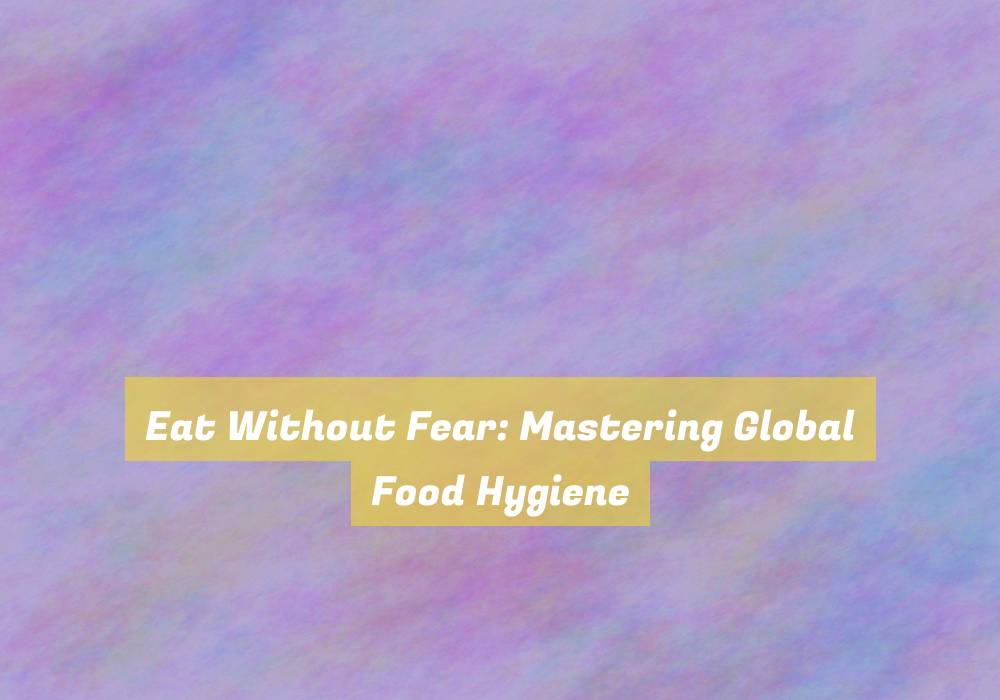Eat Without Fear: Mastering Global Food Hygiene
You know the saying, G??You are what you eat.G?? When it comes to global food hygiene, this couldnG??t ring truer.
From street food in Bangkok to fine dining in Paris, the world is full of culinary experiences waiting to be savored.
But as you embark on your gastronomic adventures, how can you be sure that what youG??re eating wonG??t leave you regretting your choices?
There are key principles and expert insights that can help you navigate the diverse landscape of global food hygiene.
Whether youG??re a seasoned traveler or simply curious about different cuisines, mastering this knowledge will empower you to savor every bite with confidence.
Understanding Food Safety Risks
When working in the food industry, itG??s crucial to be aware of the potential food safety risks that can arise from improper handling and preparation. Understanding these risks is paramount to ensuring the safety and well-being of consumers.
One significant risk is cross-contamination, which occurs when harmful microorganisms are transferred from one surface to another, such as from raw meat to ready-to-eat foods. This can result in foodborne illnesses and pose a serious threat to public health.
Another important risk to be mindful of is improper temperature control. Bacteria thrive in the temperature danger zone, between 41-?F and 135-?F (5-?C and 57-?C). Failure to store and cook food within safe temperature ranges can lead to the rapid growth of harmful bacteria, increasing the risk of foodborne illness.
Additionally, poor personal hygiene among food handlers can introduce harmful pathogens to the food. Failing to wash hands properly, wearing unclean uniforms, or working while ill can contaminate food and pose a severe risk to consumers.
Being vigilant about these potential risks and implementing stringent food safety protocols is essential to safeguarding the health of those who consume the food you handle.
Essential Hygiene Practices
To ensure food safety and prevent potential risks, itG??s essential to implement rigorous hygiene practices in every aspect of food handling and preparation.
Start by maintaining personal hygiene. Wash your hands thoroughly with soap and water before touching any food. Use clean utensils and equipment, and ensure that your cooking area is spotless.
When handling raw meat, poultry, or seafood, be vigilant in preventing cross-contamination. Store these items separately and use different cutting boards and knives to avoid spreading harmful bacteria.
Additionally, ensure that all food is cooked to the appropriate internal temperature to kill any potential pathogens.
Proper storage is also crucial. Refrigerate perishable items promptly and at the correct temperature to prevent the growth of bacteria. Regularly clean and sanitize your refrigerator and pantry to maintain a hygienic environment for your food.
Lastly, always be mindful of expiration dates and practice the principle of G??first in, first outG?? when using perishable items.
Navigating Cultural Differences
When preparing food in a culturally diverse environment, itG??s important to be mindful of varying practices and customs to ensure that everyone can enjoy a safe and respectful dining experience. Understanding cultural differences is crucial for maintaining food hygiene standards.
For example, while some cultures may prefer rare or undercooked meat, others prioritize thoroughly cooked dishes for safety reasons. Be attentive to dietary restrictions or taboos, such as avoiding certain ingredients or the preparation of vegetarian or halal meals. Additionally, handwashing customs and utensil usage can differ significantly across cultures, impacting food safety.
Communicate openly with individuals from diverse backgrounds to comprehend their specific needs and expectations. Embracing cultural diversity enriches the culinary experience but requires a comprehensive understanding of food hygiene practices worldwide. By acknowledging and respecting cultural differences, you can ensure that everyone feels included and safe when sharing meals, fostering a welcoming and harmonious dining environment for all.
Expert Tips for Safe Dining
Considering the importance of understanding cultural differences in food hygiene, mastering expert tips for safe dining is essential for ensuring a harmonious and inclusive dining experience.
When dining out globally, always prioritize establishments with a clean and tidy appearance. Additionally, itG??s crucial to ensure that the staff follows proper hygiene practices, such as wearing gloves when handling food.
When traveling to different countries, be mindful of local water and ice quality, as consuming contaminated water can lead to foodborne illnesses. Moreover, itG??s advisable to opt for cooked foods over raw options, as cooking at high temperatures can kill harmful bacteria.
Take note of any food advisories or warnings specific to the region youG??re visiting and be cautious of street vendors whose food may not meet safety standards.
Lastly, remember to wash your hands thoroughly before and after eating, using either soap and water or hand sanitizer.
Conclusion
Now that youG??ve learned about the essential hygiene practices and how to navigate cultural differences, you can fearlessly enjoy global cuisine.
Remember to always be mindful of food safety risks and follow expert tips for safe dining.
With this knowledge, you can confidently explore new flavors and dishes from around the world without fear.
Happy and safe eating!






